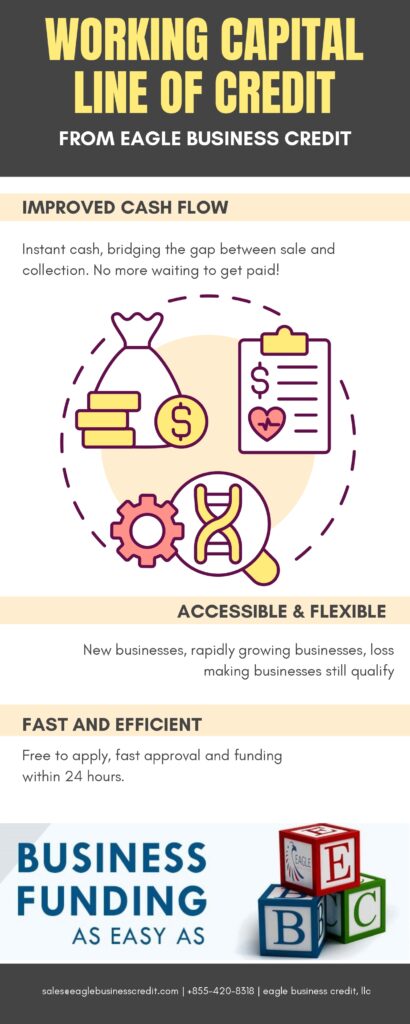A working capital line of credit serves as a vital tool for businesses to manage their day-to-day operational costs effectively. At Eagle Business Credit, we understand that steady cash flow is the lifeblood of a business and that having immediate access to capital can mean the difference between seizing an opportunity and missing it. This form of short-term financing allows companies to handle expenses such as payroll, rent, or inventory purchases without disrupting their business operations.
With a working capital line of credit, businesses benefit from the flexibility to draw funds as needed, up to a specified limit. This creates a cushion for when cash flow varies or unexpected expenses arise, ensuring that business activities can continue smoothly. Our approach is to provide a financial safety net that can adapt to the working capital needs and the unique financial cycles of each business.
Overview of Working Capital Lines of Credit
In managing the financial health of a company, it’s crucial to understand the flexible solutions available to maintain a stable cash flow. Working capital lines of credit remain an essential tool in this regard, offering a lifeline to businesses that require a buffer to meet daily operational expenses.
Defining Working Capital Line of Credit
A working capital line of credit is a tool that allows businesses to access funds up to a pre-approved limit for managing everyday operational costs. It’s a revolving line of credit which means that as business owners repay what they’ve borrowed, the capital becomes available to draw on again, thus providing a continuous source of funding. This flexibility makes it a preferred option for handling variations in cash flow, ensuring businesses can always cover short-term financial obligations such as payroll, rent, or inventory purchases.
Key Advantages for Business Owners
Utilizing a working capital line of credit offers several benefits for business owners. Most notably:
- It provides a safety net to navigate through seasonal fluctuations or unexpected expenses, without disrupting the normal business operations.
- This form of credit improves the company’s liquidity, therefore allowing for more strategic financial decisions.
- It also keeps businesses running smoothly, even during periods when incoming revenues are slow.
Understanding a prospective borrower’s creditworthiness helps us determine the terms of the credit such as the interest rate and the limit. We aim to tailor these lines of credit to fit the unique needs of each business while maintaining sustainable lending practices.
Financial Implications
In this section, we explore the specific financial aspects of a working capital line of credit, focusing on how interest rates and fees dictate costs, the structure of repayment terms, and the overall impact on a company’s cash flow and liquidity.
Interest Rates and Fees
When we obtain a working capital line of credit, interest rates play a pivotal role, as they directly influence the cost of borrowing. These rates can be variable, tied to market rates such as the prime rate, and may fluctuate over the life of the line of credit. Additionally, fees — which can include origination fees, annual fees, and transaction fees — are also critical to consider, as they add to the overall cost of financing.
Repayment Terms and Conditions
The repayment terms of a working capital line of credit determine the payments we must make over the life of the loan. These terms outline how often payments must be made (monthly, quarterly, etc.), and the conditions under which repayment must occur. It’s important for us to understand any prepayment penalties or the implications of late payments, as these can affect the financial health of our business.
Impact on Cash Flow and Liquidity
Effectively managing a working capital line of credit can significantly enhance our company’s cash flow and liquidity. It provides access to funds for covering day-to-day operating expenses, enabling us to manage the timing of our cash outflows with our cash inflows. However, it’s vital that we borrow within our means to ensure that the line of credit serves to bolster, rather than burden, our financial position.
Eligibility and Requirements
When applying for a working capital line of credit through us at Eagle Business Credit, it’s crucial to understand the specific criteria involved. The eligibility largely hinges on whether the credit is secured or unsecured, lenders’ specific evaluation criteria, and the comprehensive documentation required for the application process.
Secured vs Unsecured Lines
Secured lines of credit require collateral, such as inventory, accounts receivable, or other assets, to back the borrowed funds. This offers us extra security and may result in more favorable terms, such as lower interest rates. On the other hand, unsecured lines of credit do not require collateral, but typically involve a thorough check of the business’s creditworthiness and may come with higher interest rates due to the increased risk for the lender.
Lenders’ Evaluation Criteria
We base our assessment on several factors, including credit score, business performance, and cash flow projections. A solid business credit history can greatly improve your chances of approval, while a good personal credit score may also be taken into account, especially for small businesses. It’s important to note that different lenders have varying requirements, but a stable financial foundation is key in all cases.
Required Documentation
Our application process for a working capital line of credit is streamlined but thorough. You’ll need to provide a range of documentation, such as:
- Financial statements
- Tax returns
- Business plan
- Proof of collateral (for secured lines)
We may also request additional documents, like accounts receivable and payable aging reports, to fully understand your business’s financial health. The goal is to ensure that the line of credit fits your business’s needs and our risk profile.

Frequently Asked Questions
What are the main differences between a working capital loan and a line of credit?
A working capital loan is usually a lump-sum that a business pays back with interest over a set period. In contrast, a working capital line of credit provides a business with the flexibility to draw funds up to a certain limit and pay interest only on the amount used.
How can a working capital line of credit benefit a small business owner?
A working capital line of credit can be particularly beneficial for managing fluctuations in cash flow, allowing small business owners to cover short-term operational costs such as payroll, inventory, and rent without depleting their cash reserves.
What factors should be considered when comparing working capital line of credit rates?
When evaluating working capital lines of credit, consider factors like the interest rate, fees, repayment terms, and the lender’s reliability. It’s crucial to comprehend the overall cost of the credit line over time.
How does one calculate the appropriate amount for a working capital line of credit?
To calculate the appropriate amount, we assess our business’s current and projected cash flows, seasonal trends, and potential unforeseen expenses. This helps us determine the credit limit that aligns with our operational needs without overextending financial liabilities.
What types of expenses are typically covered by a working capital line of credit?
Typically, a working capital line of credit is used to fund everyday operational expenses such as inventory purchases, employee salaries, and urgent or unexpected costs that may arise in the daily running of a business.
What are the usual requirements to qualify for a working capital loan?
To qualify for a working capital loan, lenders typically require a solid credit history, proof of consistent revenue, and sometimes collateral. It’s essential to present detailed financial statements and a clear plan for how our business will use the credit.

